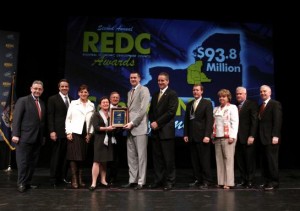A Location Efficiency metric in the Regional Economic Development Council and Cleaner Greener Communities funding programs can go a long way to ensuring that selected projects qualify as smart growth.

The REDC process has resulted in better regional economic decisions. A metric that incorporates location efficiency into the process could aid the councils to even better results. Photo of Central New York REDC Leaders.
Across New York new sustainable economic and community development trends have emerged. Manufacturing is moving back to the urban core in Central New York. Housing, offices and retail are being built around transit stops in Long Island and the HudsonValley. New York’s farmers and food producers have new opportunities for capital and distribution. In short, regions are realizing that smart growth solutions are inextricably intertwined with sustainable economic development, and that smart growth solutions are the first steps to addressing the fiscal and industrial, as well as socio-economic and demographic challenges.
Incorporating strong and smart metrics into New York’s economic development and planning initiatives will insure the best use of our limited infrastructure dollars, protect our agricultural economies and open space and develop opportunities for low and middle income populations.
Governor Cuomo has provided some innovative vehicles to achieve the desired growth. He instigated the Regional Economic Development Councils to allocate roughly $760 million annually to regional priorities and “transformative projects.” In their wake, the companion Cleaner Greener Communities effort, which engages leaders in the sustainability and economic development fields to create regional sustainability plans and performance metrics, are to guide roughly $30 million of annual funding available through the Regional Greenhouse Gas Initiative. Already, the REDC efforts have produced noticeable improvements in project selection, primarily using job creation economic development metrics. The nascent CGC sustainability plans that incorporate location efficiency metrics have the opportunity to offer an even clearer path to desired growth if applied thoroughly.
So what is location efficiency?
Location efficiency is about developing in ways that the cost to businesses, the individual, the public sector, and the environment are minimized and thought of holistically. For individuals, it is looking broadly at the costs of housing and transportation to create livable and affordable environments. Many individuals make these decisions every day, with some moving closer to a transit hub and paying a little more for housing to save much more on gasoline and automobile expenses.
Location efficiency is crucial where large sums of public money are in play. Accurately measuring the real cost of decisions requires building metrics as part of the competitive process, judging projects by comparing them to similar projects that are located in infrastructurally, environmentally, fiscally and demographically advantaged areas.
What is a “Location Efficient” Project?
- Has the greatest synergistic value in terms of effect on nearby home/industrial/retail or commercial values.
- Utilizes existing water/sewer/sidewalk/ road infrastructure
- Reuses vacant or abandoned buildings or land
- Supportive of local retail
- Located near areas of high unemployment
- Reduces employee transportation cost and gasoline expenses
- Public Health benefits of connectivity and walkability
- Accessible by and supportive of public transit, walking or biking
Points should be deducted from project sited less-efficiently:
- Engenders additive vehicle-miles-traveled
- Generates additional greenhouse gases
- Adds to employee transportation costs and gasoline expenses
- Necessitates new water, sewer, or road infrastructure
- Is destructive of wild habitats or farmland
- Lessen regional water quality
- Do not support walking or biking
How would this work?
Imagine that a regional council prioritizes a subsidy for a project that will generate a given number of jobs, and that project will be miles from the center of the region in a Greenfield, suburban office park or industrial park. At the same time, there is an almost identical project or a project that focuses on strategic energy retrofits or another priority, with just a slightly less-deserving ratio of jobs/subsidy dollar, located within the region’s center.
Under most, but not all, circumstances, this would mean that the further a given project is from a regional or transit center, the more points will be lost.
This scoring is not arbitrary imposed values. They are a reflection of state law as embodied in the NYS Public Infrastructure Policy Act — a law that passed in 2010 overwhelmingly in both the State Senate and Assembly.
And these points, for or against, represent very real costs to the public, to state agencies and to municipalities. Such costs or benefits ought be quantified, made public, and applied to the Regional Economic Development Councils’ project selection processes and project scoring. If this or a similar approach is applied to the 20 percent of the project scoring that is done at the regional level, then by law and by common sense, it ought to be done by the Governor’s staff and agencies at the state level in regard to the 80 percent they assign.
Cleaner Greener Communities has the opportunity to be more than a stand-alone effort. Location efficiency models developed through CGC, that compare projects in the right places to those that are not, would be an enhanced metric for the Regional Economic Development Councils. Such a tool would put New York State and all of our respective regions on the path to greater, greener, and lasting economic success.

In Genesee County, an Agricultural Business Park may be an appropriate investment in an agricultural community, while other public investments in infrastructure and economic development are more efficient if they are closer to an urban population centers.
Photo credit: Genesee County Economic Development Center



